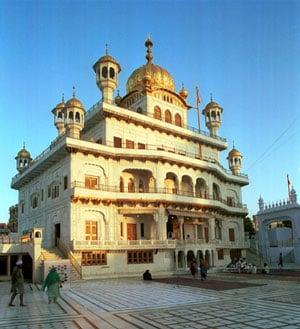Template:Today's featured article: Difference between revisions
From SikhiWiki
Jump to navigationJump to search
Navroopsehmi (talk | contribs) |
Navroopsehmi (talk | contribs) |
||
| Line 1: | Line 1: | ||
== | ==Akal Takhat : Throne of the Immortal== | ||
[[Image: | [[Image:Akal-takhat-2.jpg|thumb|The Akal Takhat in the morning as the sun rises|left]] | ||
Two years after the Guru Granth Sahib was installed in the Harimandir Sahib, its compiler, Guru Arjan Dev ji was arrested and tortured to death by order of the Mughal Emperor Jehangir, for harbouring the enemy’s rebel son Khusro. This tragic turning point left a deep impression on the Sikh psyche in the form of a sharp and sudden awareness of the concept of martyrdom. Before his death, anticipating that the end was near, Guru Arjan Dev ji in a parting message to his son asked him to, “sit fully armed on his throne and maintain an army.” And Guru Hargobind did just that, On Monday, the fifth day of the light half of Har, Sambat 1663, Guru Hargobind ji laid the foundation of the Takhat Akal Bunga. | |||
'''[[Akal Takhat|....Continued]]''' | |||
'''[[ | |||
Revision as of 08:24, 6 June 2005
Akal Takhat : Throne of the Immortal
Two years after the Guru Granth Sahib was installed in the Harimandir Sahib, its compiler, Guru Arjan Dev ji was arrested and tortured to death by order of the Mughal Emperor Jehangir, for harbouring the enemy’s rebel son Khusro. This tragic turning point left a deep impression on the Sikh psyche in the form of a sharp and sudden awareness of the concept of martyrdom. Before his death, anticipating that the end was near, Guru Arjan Dev ji in a parting message to his son asked him to, “sit fully armed on his throne and maintain an army.” And Guru Hargobind did just that, On Monday, the fifth day of the light half of Har, Sambat 1663, Guru Hargobind ji laid the foundation of the Takhat Akal Bunga.

